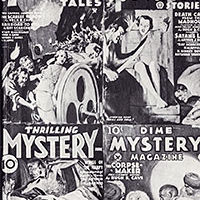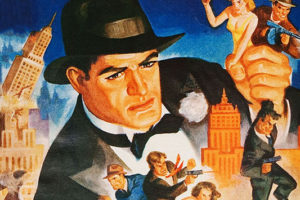After getting the first volume of Madame Storey stories from Steeger Books, I have gotten the second one, The Viper: The Complete Cases of Madame Storey, Vol. 2.
 The series was written by Hulbert Footner (1879-1944), a Canadian author who wrote for the pulps, as well as books, first westerns, then adventure tales set in the Canadian Northwest, and later detective stories. This is one of the rare groups of female detective stories in the pulps. His Madame Storey series ran for 30 stories in Argosy All-Story from 1922 to 1930.
The series was written by Hulbert Footner (1879-1944), a Canadian author who wrote for the pulps, as well as books, first westerns, then adventure tales set in the Canadian Northwest, and later detective stories. This is one of the rare groups of female detective stories in the pulps. His Madame Storey series ran for 30 stories in Argosy All-Story from 1922 to 1930.
Most of the stories are novelette length, so there are few recurring characters, and we don’t get much background on many. We meet Madame Rosika Storey (or is it Rozika?) in the first story. Her occupation is “practical psychology, specializing in the feminine.” She doesn’t present herself as a detective, per se, as she solves all sorts of human problems, not just those dealing with crime. Other past and current cases are mentioned by name. She is unmarried, probably in her 30s, and well dressed for the time. We don’t get anything on her background. Oh, and she has a pet monkey, Giannino, whom she brings to her office, but it doesn’t play a role. At least not in these tales.
Her assistant, her “Dr. Watson,” is Bella Brickley, who we are also introduced to in the first story, as we see her get hired after Storey puts in an ad looking for a “woman of common sense” to work for her. Brickley narrates all the stories, so is our entry into them.
And there is Fred, the “hall boy,” or I guess page boy, at the building where Storey has her offices. He has a minor role in the first story but is only mentioned in the next two. He doesn’t appear in any of the stories in this volume, so I suspect he was dropped entirely.
Storey apparently has a cadre of agents working for her, what with the many cases she has. Some are mentioned, but one, Sidney Farren, along with his younger brother, makes an appearance in the second story (in the previous volume), and Sidney Crider makes an appearance in the third story, also with a younger brother. Crider appears in the last two of these stories, and we hear of others such as Sanders and Canby, as well as a new agent, Sampson, an Englishman in the last.
Vol. 2 has the next three stories, all dealing with murder and crime. Unlike the first set, not all her clients are women.
First up is “In the Round Room” (March 1, 1924), which strangely starts before a crime has occurred. A Norbert Starr appears. He is from a rich family and is notorious for appearing in the papers. Some years back he married a music hall star, a Bessie Jewel, who was 10 years older than him. She had him build a castle, Bolingbroke Castle. But the marriage is not working and he is having problems getting a divorce (this was harder to do back then) after getting legally separated. And now he has actually fallen in love. He hopes to enlist Storey to talk with his wife and make her see reason (i.e. agree to the divorce), but she turns him down. Then Mrs. Starr shows up.
A few days later, Norbert calls to ask Storey to come to the Castle as his wife has committed suicide in her office in the “round room.” But why call her in? Turns out that after the couple had a discussion in the room, Norbert left the room and a shot sounded. Mrs. Starr was shot, an apparent suicide. But the gun she held had not been fired and no other gun is evident. Mrs. Starr’s mother and sister, the only other residents of the house, were out. The county prosecutor thinks Norbert is guilty. Things get complicated when the woman Norbert is interested in is found near the round room. Can Storey figure out who did it?
I was really surprised by who did it, more because the story also included someone with dual personalities. I didn’t think that was an idea that was accepted back then. I also found the part where Storey figures out the height of the person who shot Mrs. Starr interesting. Such forensic science is a given today, but I don’t think so back then.
In “The Viper” (April 12, 1924), Storey is about to depart for her annual vacation to Paris, when she has a visitor, the recently widowed Mrs. Daniel Greenfield. Her husband had died of a cerebral hemorrhage eight months prior. She suspects murder by his long-time secretary who had access to all his accounts. But she has no proof of this, only a suspicion. She remembered her husband saying a few weeks before he passed that if he did, his worth would be $10 million, but in the end it was only $9 million. She can’t believe he was that much off. And his former secretary had left for Paris herself two months prior.
Storey takes the case and brings along Brickley while Crider investigates things locally. There, they find an American woman who claims to be a widow and wants to be “the most talked about woman in Paris” and has now taken up with a French prince. Thus, after three days, Storey sends Brickley back, and we get an interesting sequence of telegraphs going back and forth as they investigate the woman back in the U.S. Then the woman marries the prince and is heading back to the U.S. Storey sneaks back right after them.
Once Storey returns to New York, they must work quickly as the couple will be heading out, and they won’t be able to trap her. She invites the former secretary and her husband to dinner and lays out what happens. This is very interesting, especially at the end of it all. We have someone who seems almost like a sociopath.
And finally, we get “The Smoke Bandit” (June 28, 1924). This one is a doozy. We are told the story occurred seven years prior, and that Brickley has decided to write it up. At first, it seems a pretty simple crime tale. Several banks are hit by a bandit who uses smoke bombs, but he was never caught. But a Walter Barron, a former DA who has set up his own detective agency, is working to find the criminal. He has a past romantic tie with Storey (he appeared in the second story), and so this turns into a sort of rivalry between the two detectives. And it seems that Barron wins when the bandit is cornered but kills himself.
But then Storey, with the backing of her main agent Crider, comes into the meeting where Barron will meet with the group of bankers in his moment of triumph and reveals who the real bandit is and who is behind it. The whole thing is a shocker.
I found all of these stories well-written. In some ways, Storey is a female Sherlock Holmes. She looks for physical evidence and also interviews folks to figure out who has been doing what, often causing the guilty party to confess. In fact, as I read the three stories here, I felt that just on the power of the last section laying out the crime and the guilty party confessing, or at least not being able to deny it, that this would make for a great dramatic TV crime series. And the villains here are pretty interesting in their own right.
A third volume is already out with the next two stories. I suspect it will take about 10 volumes in total to reprint them all. I don’t know the source of the cover artwork as these stories weren’t cover featured at first. But it is a good choice as it’s how I imagine Storey’s appearance.
For those wanting to see female pulp protagonists, this series is a great example of that. I’m glad I got the first volume, and find this one another enjoyable series. I’ll definitely be getting the new ones.



